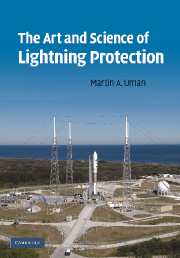Book contents
- Frontmatter
- Contents
- Preface
- 1 What is lightning?
- 2 Lightning damage
- 3 General methods for lightning protection: Faraday cages, topological shields; and more practical approaches: cone of protection and rolling sphere methods
- 4 Structure protection: air terminals and down conductors
- 5 Structure protection: grounding
- 6 Surge protection for electronics in low-voltage electrical systems
- 7 Humans and animals
- 8 Lightning warning
- 9 Airships, airplanes, and launch vehicles
- 10 Ships and boats
- 11 Trees
- 12 Overhead and underground power and communication lines
- 13 Lightning elimination
- 14 So, what do we know and what don't we know about lightning protection?
- Index
- References
1 - What is lightning?
Published online by Cambridge University Press: 17 November 2009
- Frontmatter
- Contents
- Preface
- 1 What is lightning?
- 2 Lightning damage
- 3 General methods for lightning protection: Faraday cages, topological shields; and more practical approaches: cone of protection and rolling sphere methods
- 4 Structure protection: air terminals and down conductors
- 5 Structure protection: grounding
- 6 Surge protection for electronics in low-voltage electrical systems
- 7 Humans and animals
- 8 Lightning warning
- 9 Airships, airplanes, and launch vehicles
- 10 Ships and boats
- 11 Trees
- 12 Overhead and underground power and communication lines
- 13 Lightning elimination
- 14 So, what do we know and what don't we know about lightning protection?
- Index
- References
Summary
Types of lightning
Lightning is a very long electrical spark, “very long” meaning greater than about 1 kilometer. Most lightning is generated in summer thunderstorms and is characterized by a length of 5 to 10 km, at the extreme about 100 km. The longest electrical sparks that can commonly be generated in the laboratory measure 1 to 3 meters, with the maximum being 10 to 20 m. In swirling desert sand storms, sparks occur that are a few meters in length (Kamra 1972a, b). Sparks this short are generally not called lightning. Some volcanoes produce kilometer-length electrical discharges in their ejected material, so-called “volcano lightning” (e.g., Anderson et al. 1965, Brook et al. 1974a, b, McNutt and Davis 2000). Even longer discharges, called “nuclear lightning,” were produced by near-surface thermonuclear (H-bomb) explosions in the 1950s (testing that has since been discontinued), the electrical charge source for the nuclear lightning being the negative charge (electrons) blasted upward into the atmosphere by the detonation (e.g., Uman et al. 1972, Williams et al. 1988). Video records taken both by the Galileo orbiter as it circled the planet Jupiter and by earlier fly-by spacecraft document that lightning occurs in the clouds of that planet (e.g., Borucki and Magalhaes 1992, Little et al. 1999), and there is evidence that lightning also occurs on Saturn.
- Type
- Chapter
- Information
- The Art and Science of Lightning Protection , pp. 1 - 24Publisher: Cambridge University PressPrint publication year: 2008



